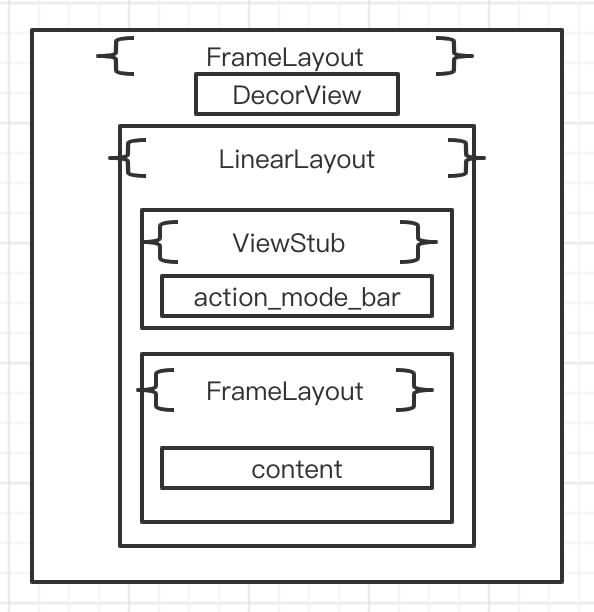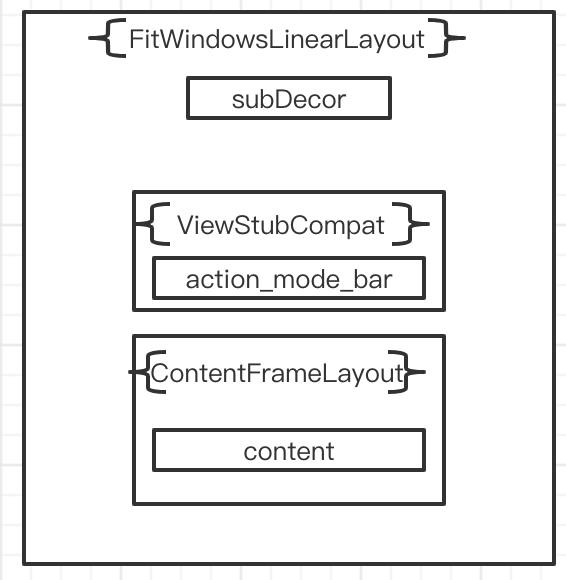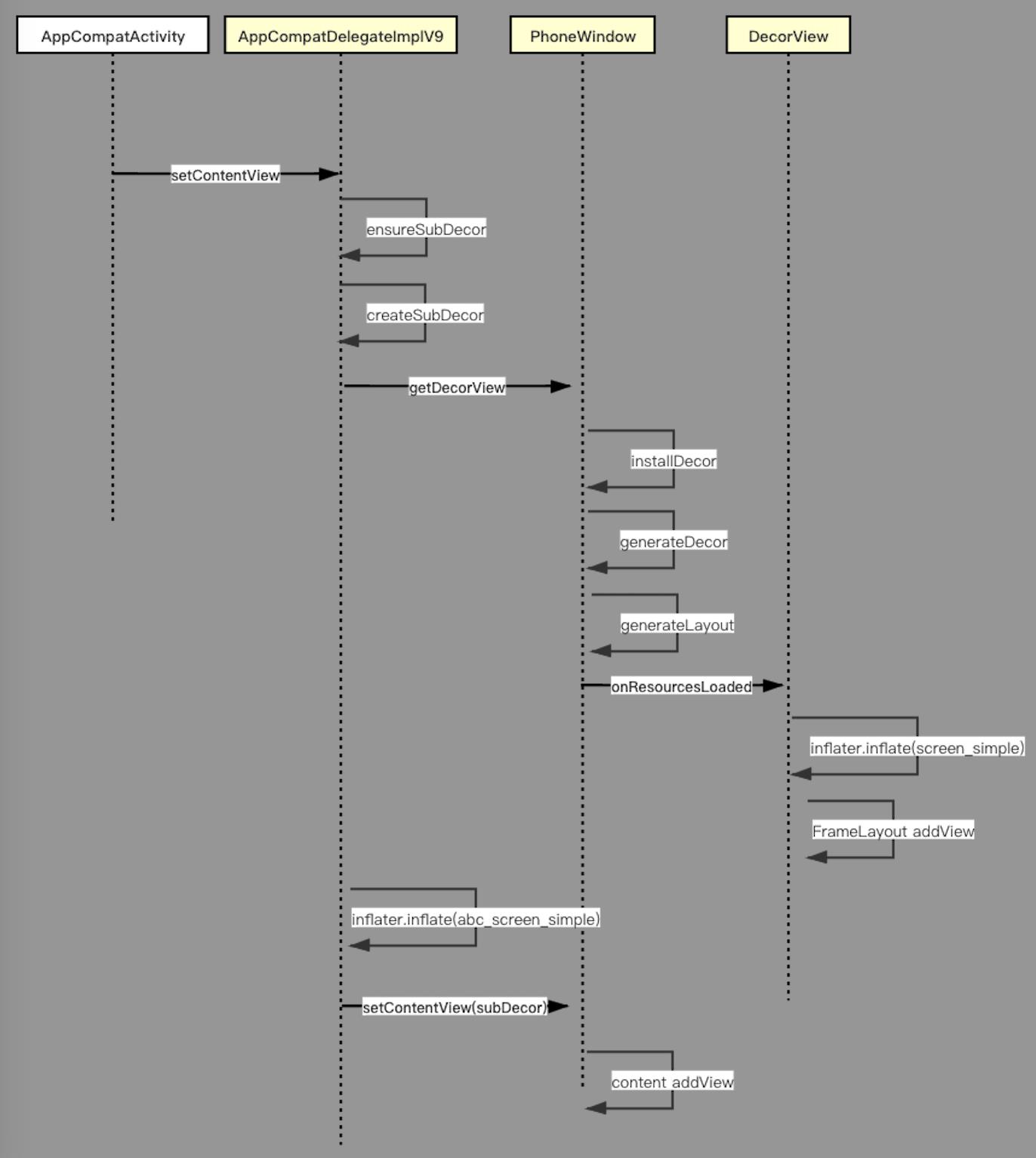setContentView流程
Posted cao_null
tags:
篇首语:本文由小常识网(cha138.com)小编为大家整理,主要介绍了setContentView流程相关的知识,希望对你有一定的参考价值。
AppCompatActivity的方法实际是调用


先获取AppCompatDelegate委托类,最终调用AppCompatDelegateImplV9,只分析最常用的方法:

所有方法都用到了ensureSubDecor
private void ensureSubDecor()
if (!mSubDecorInstalled) //确保执行一次
mSubDecor = createSubDecor();
// If a title was set before we installed the decor, propagate it now
CharSequence title = getTitle();
if (!TextUtils.isEmpty(title))
onTitleChanged(title);//设置title
applyFixedSizeWindow();
onSubDecorInstalled(mSubDecor);
mSubDecorInstalled = true;
// Invalidate if the panel menu hasn't been created before this.
// Panel menu invalidation is deferred avoiding application onCreateOptionsMenu
// being called in the middle of onCreate or similar.
// A pending invalidation will typically be resolved before the posted message
// would run normally in order to satisfy instance state restoration.
PanelFeatureState st = getPanelState(FEATURE_OPTIONS_PANEL, false);
if (!isDestroyed() && (st == null || st.menu == null))
invalidatePanelMenu(FEATURE_SUPPORT_ACTION_BAR);
创建SubDecor
private ViewGroup createSubDecor()
TypedArray a = mContext.obtainStyledAttributes(R.styleable.AppCompatTheme);
if (!a.hasValue(R.styleable.AppCompatTheme_windowActionBar))
a.recycle();
throw new IllegalStateException(
"You need to use a Theme.AppCompat theme (or descendant) with this activity.");
if (a.getBoolean(R.styleable.AppCompatTheme_windowNoTitle, false))
requestWindowFeature(Window.FEATURE_NO_TITLE);
...省略
mIsFloating = a.getBoolean(R.styleable.AppCompatTheme_android_windowIsFloating, false);
a.recycle();//设置主题
// Now let's make sure that the Window has installed its decor by retrieving it
mWindow.getDecorView();
final LayoutInflater inflater = LayoutInflater.from(mContext);
ViewGroup subDecor = null;
if (!mWindowNoTitle)
if (mIsFloating)
// If we're floating, inflate the dialog title decor
subDecor = (ViewGroup) inflater.inflate(
R.layout.abc_dialog_title_material, null);
...省略生成设置subDecor
// Now set the Window's content view with the decor
mWindow.setContentView(subDecor);//设置在这
contentView.setAttachListener(new ContentFrameLayout.OnAttachListener()
@Override
public void onAttachedFromWindow()
@Override
public void onDetachedFromWindow()
dismissPopups();
);
return subDecor;
最终设置contentview
@Override
public void setContentView(View view, ViewGroup.LayoutParams params)
// Note: FEATURE_CONTENT_TRANSITIONS may be set in the process of installing the window
// decor, when theme attributes and the like are crystalized. Do not check the feature
// before this happens.
if (mContentParent == null)
installDecor();
else if (!hasFeature(FEATURE_CONTENT_TRANSITIONS))
mContentParent.removeAllViews();
if (hasFeature(FEATURE_CONTENT_TRANSITIONS))
view.setLayoutParams(params);
final Scene newScene = new Scene(mContentParent, view);
transitionTo(newScene);
else
mContentParent.addView(view, params);//addview在这
mContentParent.requestApplyInsets();
final Callback cb = getCallback();
if (cb != null && !isDestroyed())
cb.onContentChanged();
mContentParentExplicitlySet = true;
安装Decor
private void installDecor()
mForceDecorInstall = false;
if (mDecor == null)
mDecor = generateDecor(-1);//创建
mDecor.setDescendantFocusability(ViewGroup.FOCUS_AFTER_DESCENDANTS);
mDecor.setIsRootNamespace(true);
if (!mInvalidatePanelMenuPosted && mInvalidatePanelMenuFeatures != 0)
mDecor.postOnAnimation(mInvalidatePanelMenuRunnable);
else
mDecor.setWindow(this);
if (mContentParent == null)
mContentParent = generateLayout(mDecor);//生成布局
。。。省略
创建的DecorView是一个FrameLayout
protected DecorView generateDecor(int featureId)
// System process doesn't have application context and in that case we need to directly use
// the context we have. Otherwise we want the application context, so we don't cling to the
// activity.
Context context;
if (mUseDecorContext) //Activity才为true
Context applicationContext = getContext().getApplicationContext();
if (applicationContext == null)
context = getContext();
else
context = new DecorContext(applicationContext, getContext());
if (mTheme != -1)
context.setTheme(mTheme);
else
context = getContext();
return new DecorView(context, featureId, this, getAttributes());
public class DecorView extends FrameLayout implements RootViewSurfaceTaker, WindowCallbacks 生成布局
protected ViewGroup generateLayout(DecorView decor)
// Apply data from current theme.
...省略跟主题和样式相关
else
// Embedded, so no decoration is needed.
layoutResource = R.layout.screen_simple;
// System.out.println("Simple!");
mDecor.startChanging();
mDecor.onResourcesLoaded(mLayoutInflater, layoutResource);
ViewGroup contentParent = (ViewGroup)findViewById(ID_ANDROID_CONTENT);//contentParent就是id为content的FrameLayout
if (contentParent == null)
throw new RuntimeException("Window couldn't find content container view");
if ((features & (1 << FEATURE_INDETERMINATE_PROGRESS)) != 0)
ProgressBar progress = getCircularProgressBar(false);
if (progress != null)
progress.setIndeterminate(true);
if ((features & (1 << FEATURE_SWIPE_TO_DISMISS)) != 0)
registerSwipeCallbacks(contentParent);
// Remaining setup -- of background and title -- that only applies
// to top-level windows.
if (getContainer() == null)
final Drawable background;
if (mBackgroundResource != 0)
background = getContext().getDrawable(mBackgroundResource);
else
background = mBackgroundDrawable;
mDecor.setWindowBackground(background);
final Drawable frame;
if (mFrameResource != 0)
frame = getContext().getDrawable(mFrameResource);
else
frame = null;
mDecor.setWindowFrame(frame);
mDecor.setElevation(mElevation);
mDecor.setClipToOutline(mClipToOutline);
if (mTitle != null)
setTitle(mTitle);
if (mTitleColor == 0)
mTitleColor = mTextColor;
setTitleColor(mTitleColor);
mDecor.finishChanging();
return contentParent;
查看布局文件
<LinearLayout xmlns:android="http://schemas.android.com/apk/res/android"
android:layout_width="match_parent"
android:layout_height="match_parent"
android:fitsSystemWindows="true"
android:orientation="vertical">
<ViewStub android:id="@+id/action_mode_bar_stub"
android:inflatedId="@+id/action_mode_bar"
android:layout="@layout/action_mode_bar"
android:layout_width="match_parent"
android:layout_height="wrap_content"
android:theme="?attr/actionBarTheme" />
<FrameLayout
android:id="@android:id/content"
android:layout_width="match_parent"
android:layout_height="match_parent"
android:foregroundInsidePadding="false"
android:foregroundGravity="fill_horizontal|top"
android:foreground="?android:attr/windowContentOverlay" />
</LinearLayout>嵌套关系如图

AppCompatDelegateImplV9中生成的view布局 abc_screen_simple
<?xml version="1.0" encoding="utf-8"?>
<!-- Copyright (C) 2013 The Android Open Source Project
Licensed under the Apache License, Version 2.0 (the "License");
you may not use this file except in compliance with the License.
You may obtain a copy of the License at
http://www.apache.org/licenses/LICENSE-2.0
Unless required by applicable law or agreed to in writing, software
distributed under the License is distributed on an "AS IS" BASIS,
WITHOUT WARRANTIES OR CONDITIONS OF ANY KIND, either express or implied.
See the License for the specific language governing permissions and
limitations under the License.
-->
<android.support.v7.widget.FitWindowsLinearLayout
xmlns:android="http://schemas.android.com/apk/res/android"
android:id="@+id/action_bar_root"
android:layout_width="match_parent"
android:layout_height="match_parent"
android:orientation="vertical"
android:fitsSystemWindows="true">
<android.support.v7.widget.ViewStubCompat
android:id="@+id/action_mode_bar_stub"
android:inflatedId="@+id/action_mode_bar"
android:layout="@layout/abc_action_mode_bar"
android:layout_width="match_parent"
android:layout_height="wrap_content" />
<include layout="@layout/abc_screen_content_include" />
</android.support.v7.widget.FitWindowsLinearLayout>嵌套关系图最后加到content中

最后看
@Override
public void setContentView(View view, ViewGroup.LayoutParams params)
// Note: FEATURE_CONTENT_TRANSITIONS may be set in the process of installing the window
// decor, when theme attributes and the like are crystalized. Do not check the feature
// before this happens.
if (mContentParent == null)
installDecor();
else if (!hasFeature(FEATURE_CONTENT_TRANSITIONS))
mContentParent.removeAllViews();
if (hasFeature(FEATURE_CONTENT_TRANSITIONS))
view.setLayoutParams(params);
final Scene newScene = new Scene(mContentParent, view);
transitionTo(newScene);
else
mContentParent.addView(view, params);
mContentParent.requestApplyInsets();
final Callback cb = getCallback();
if (cb != null && !isDestroyed())
cb.onContentChanged();
mContentParentExplicitlySet = true;
分析到这基本上流程已经梳理清晰了。

总的布局结构

以上是关于setContentView流程的主要内容,如果未能解决你的问题,请参考以下文章